Overview
This article presents a comprehensive approach to effective power outage risk management. It underscores the critical need for proactive planning, thorough resource assessment, and ongoing improvement strategies.
Establishing emergency response teams, documenting response plans, and conducting regular drills are essential steps that collectively bolster preparedness and resilience against power disruptions. By implementing these strategies, organizations can significantly enhance their ability to manage risks associated with power outages, ensuring a robust response when challenges arise.
Introduction
Power outages disrupt daily life and critical operations across industries, posing significant risks to infrastructure and safety. Effective power outage risk management is essential for organizations striving to minimize these disruptions and maintain operational continuity. This article outlines ten strategic steps organizations can implement to enhance their preparedness and response capabilities.
How can leaders ensure their teams are equipped to navigate the complexities of power interruptions? What proactive measures can be taken to safeguard against unforeseen challenges?
Harbinger Land | Comprehensive Solutions for Power Outage Risk Management
Harbinger Land stands at the forefront of comprehensive solutions for power outage risk management, especially within energy and infrastructure projects. Their suite of services encompasses site and right-of-way acquisition, title research, GIS mapping, and data processing, all meticulously tailored to tackle the unique challenges posed by electrical interruptions. By harnessing advanced technologies, such as AI-powered title research software and highly integrated GIS modeling services, Harbinger Land significantly elevates operational efficiency and client satisfaction. This unwavering commitment to innovation positions them as an indispensable partner for organizations navigating the complexities of power disruptions.
In addition to their acquisition services, Harbinger Land excels in digitizing property data through efficient document imaging solutions. These solutions empower title agents to conduct title research and leasing in a cost-effective manner by providing rapid access to extensive datasets, thereby streamlining the acquisition process and enhancing overall efficiency.
Case studies underscore the effectiveness of their approach: for instance, the Adaptive Networked Microgrid (ANM) project by DTE Energy aims to reduce interruptions by up to 80% through renewable energy solutions, showcasing the potential of integrated systems in bolstering reliability. Furthermore, the Jamestown Community Microgrid Project illustrates the importance of localized energy solutions, ensuring that essential services remain operational during disruptions. These examples highlight the broader impact of power interruptions on energy infrastructure, reinforcing the necessity for robust power outage risk management strategies.
In a landscape where severe weather events contribute significantly to disruptions, Harbinger Land's proactive measures and innovative solutions for power outage risk management are vital for mitigating risks and ensuring the resilience of energy projects. As Joan Casey, an assistant professor, aptly noted, "Power interruptions impact millions of individuals and incur billions of dollars each year," underscoring the imperative of implementing comprehensive solutions.
Develop a Power Outage Emergency Response Plan
A successful emergency response strategy must detail specific measures for implementation before, during, and after a disruption, incorporating power outage risk management. This includes:
- Identifying critical operations
- Establishing communication protocols
- Designating responsibilities among team members
Regularly examining and updating the plan is crucial for power outage risk management, ensuring its relevance and effectiveness in addressing potential outages.
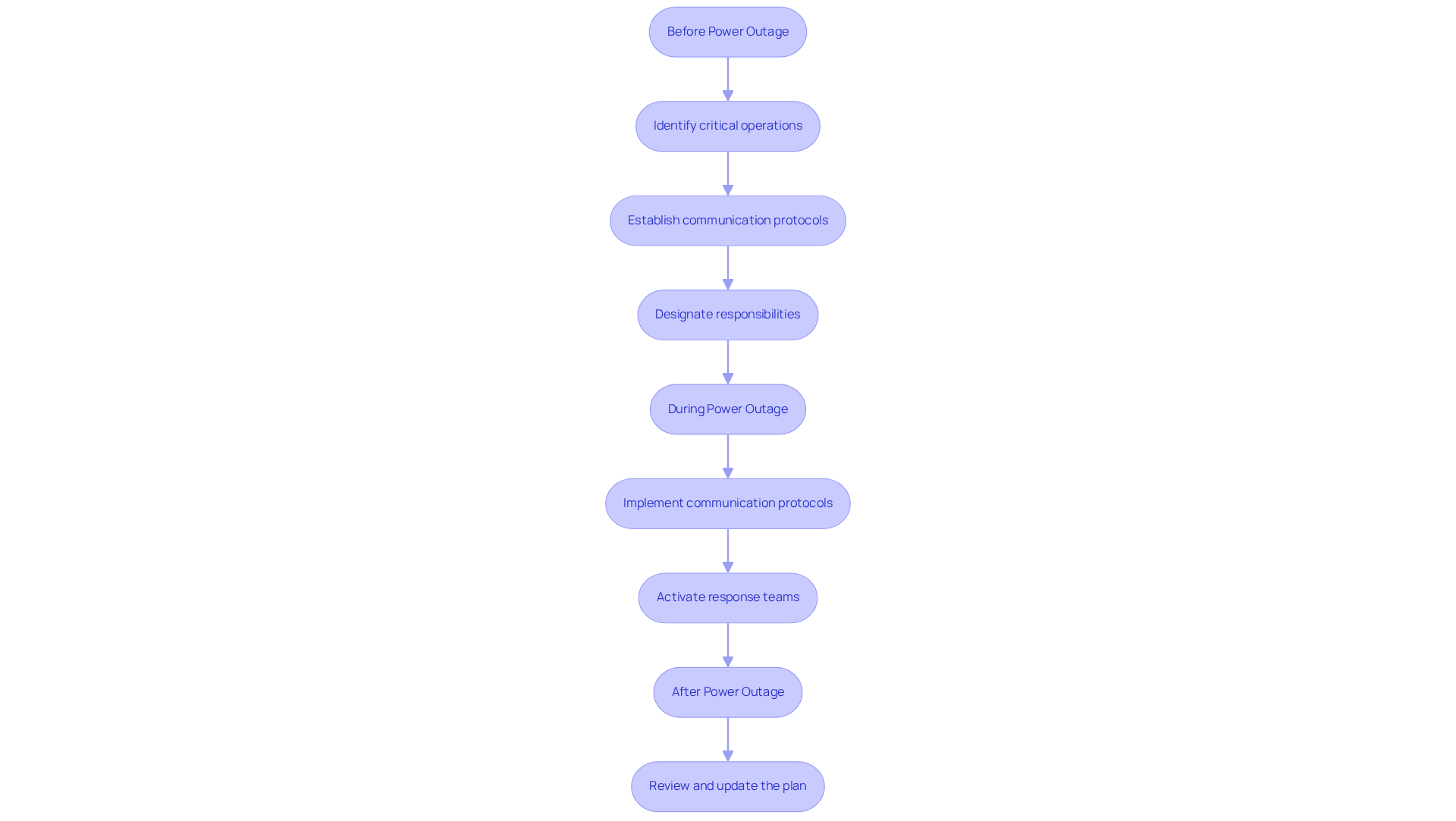
Identify Potential Threats to Power Supply
Organizations must conduct a thorough evaluation for power outage risk management to identify potential risks to their energy supply. This evaluation should encompass risks posed by natural disasters, equipment malfunctions, and cybersecurity vulnerabilities. For instance, the U.S. Energy Grid, with 70% of its transmission lines over 30 years old, faces significant risks from aging infrastructure, contributing to an annual utility distribution spending of $51 billion. Additionally, physical attacks on the grid surged by 77% in 2022, underscoring the urgent need for enhanced security measures.
Natural calamities, such as floods and earthquakes, can significantly disturb energy supply, as demonstrated by Japan's ongoing issues with disaster readiness. Historical data reveals that natural disasters have caused substantial fatalities, prompting the government to prioritize holistic disaster management. The incorporation of risk evaluations, featuring a three-dimensional measure of social vulnerability, can assist utilities in managing operations during disruptions more equitably. Specialists emphasize that comprehending these dangers is essential for creating efficient approaches to power outage risk management, which helps reduce risks and strengthen resilience against electricity interruptions. By prioritizing these assessments, organizations can better prepare for the multifaceted challenges that threaten their energy supply.
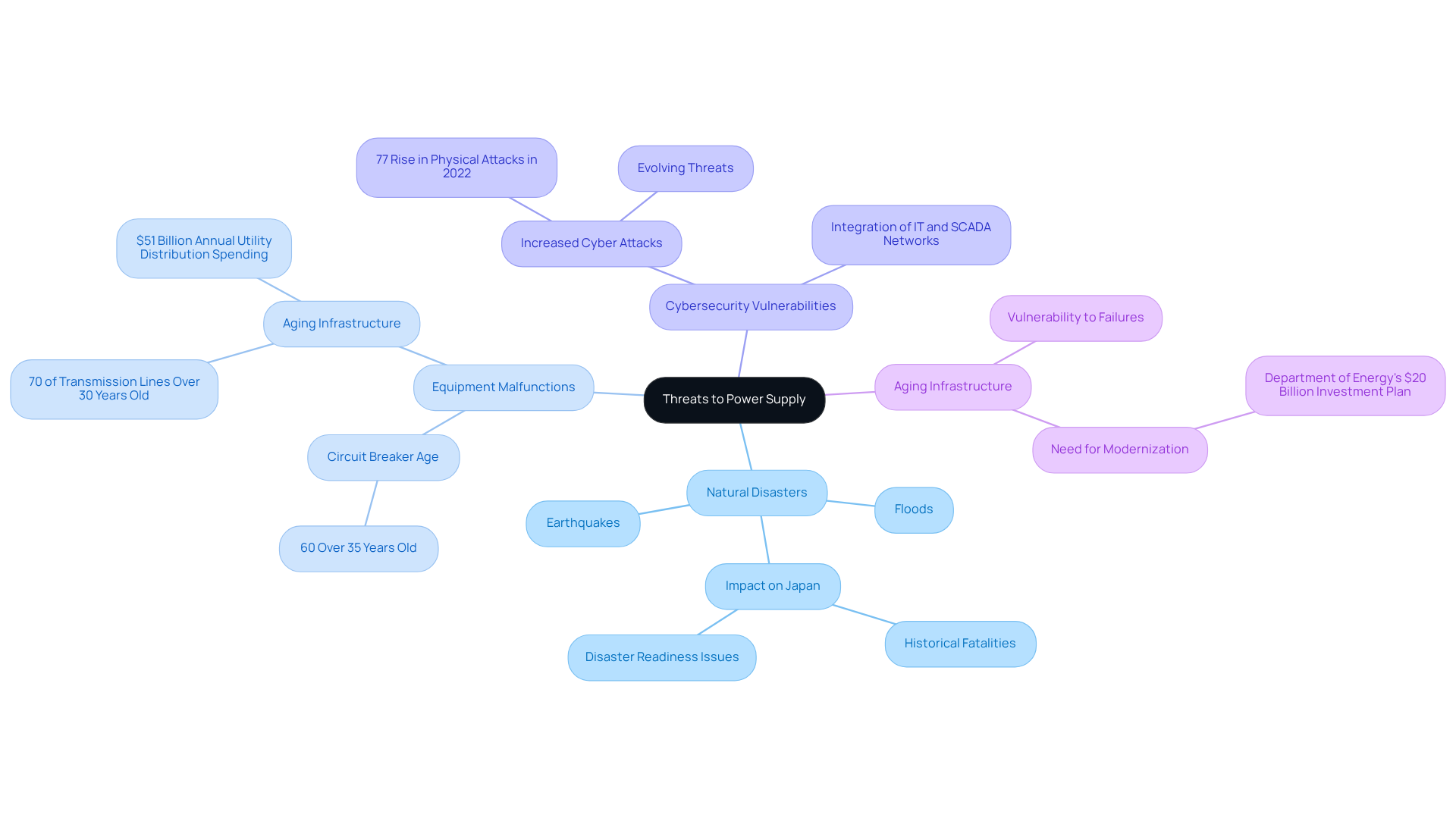
Gather Contact Information for Key Stakeholders
Gathering a comprehensive list of contact details for key stakeholders—including utility firms, crisis services, and internal team members—is essential for effective power outage management. This list must be easily accessible and regularly updated to ensure prompt communication during emergencies. Establishing a robust communication plan that clearly outlines how and when to contact these stakeholders can significantly enhance response efforts. As Jennie King aptly stated, "We all recognize that electrical interruptions are frequently beyond the utility’s control, but keeping customers updated is entirely within the utility’s control." Effective communication during disruptions not only strengthens relationships but also ensures that all parties are informed and coordinated.
With approximately 44% of energy interruptions linked to storm-related incidents, prioritizing stakeholder communication becomes increasingly critical. By addressing the challenges utilities face, such as relying on customers to report problems—which can lead to high call volumes—organizations can improve their crisis management capabilities and enhance overall response efficiency.
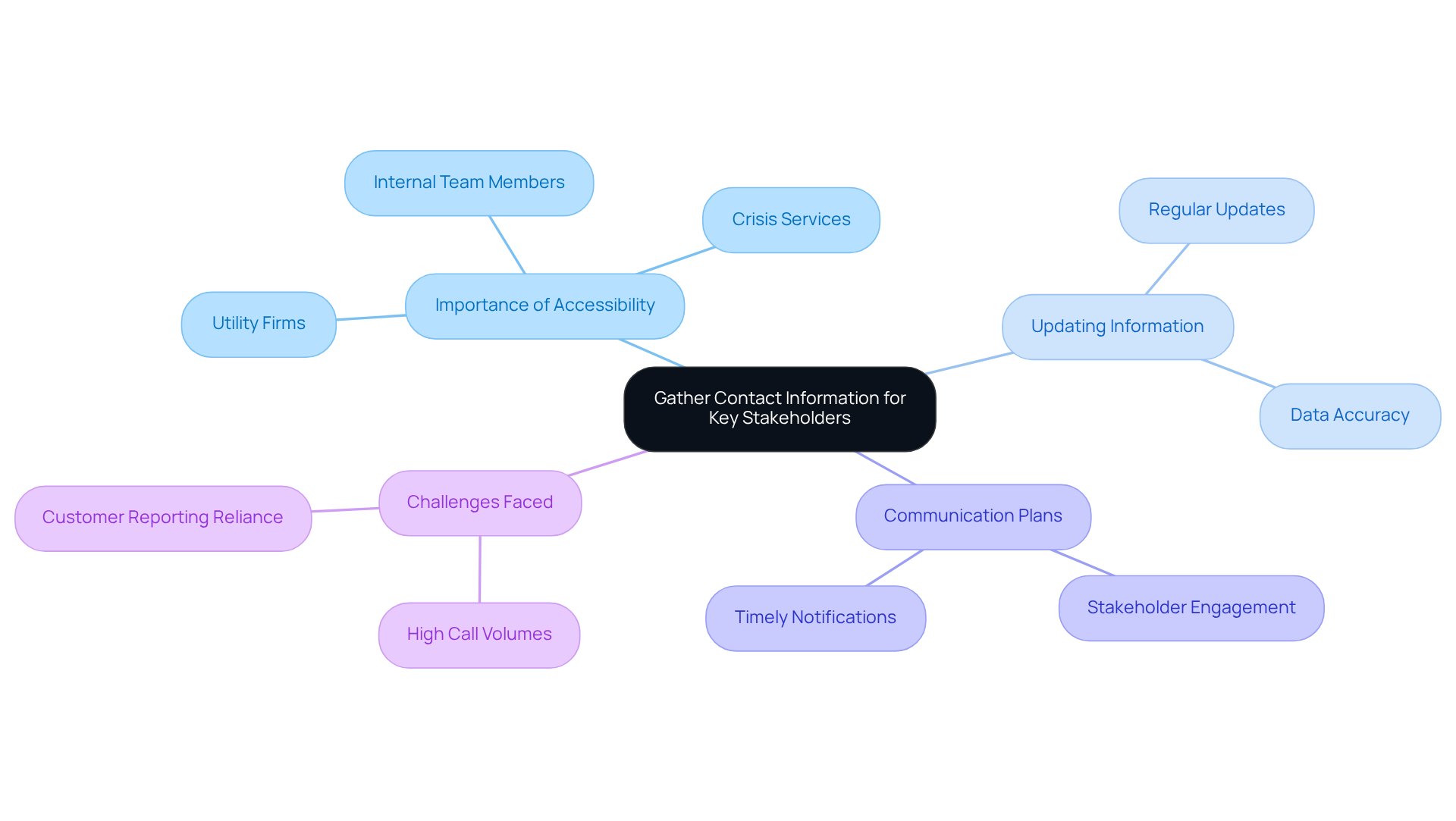
Build an Emergency Response Team
Establishing a rapid response team equipped with a diverse skill set is crucial for effective power outage risk management. This team must comprise individuals proficient in urgent protocols, crisis communication, and resource distribution, enabling them to respond adeptly to a range of situations. Clearly defined roles within the team, encompassing communication, safety, equipment, and facilities personnel, are essential for enhancing operational efficiency during crises.
Consistent training initiatives, such as CyberStrike and the Clear Path Exercise Series, are vital for ensuring team members are prepared to act swiftly and effectively during actual disruptions. These exercises not only bolster practical skills but also promote collaboration among team members, significantly improving overall readiness. Furthermore, continuous training requirements, including refresher courses every few years, are necessary to sustain a high level of preparedness, allowing the team to adapt to the evolving challenges within the energy sector.
Moreover, implementing crisis communication strategies that leverage multiple channels ensures timely information dissemination during critical situations, further augmenting the team's response capabilities. Are your team members equipped to handle the complexities of power outages? By prioritizing training and communication, you can enhance your organization’s resilience against unforeseen challenges, which is essential for effective power outage risk management.
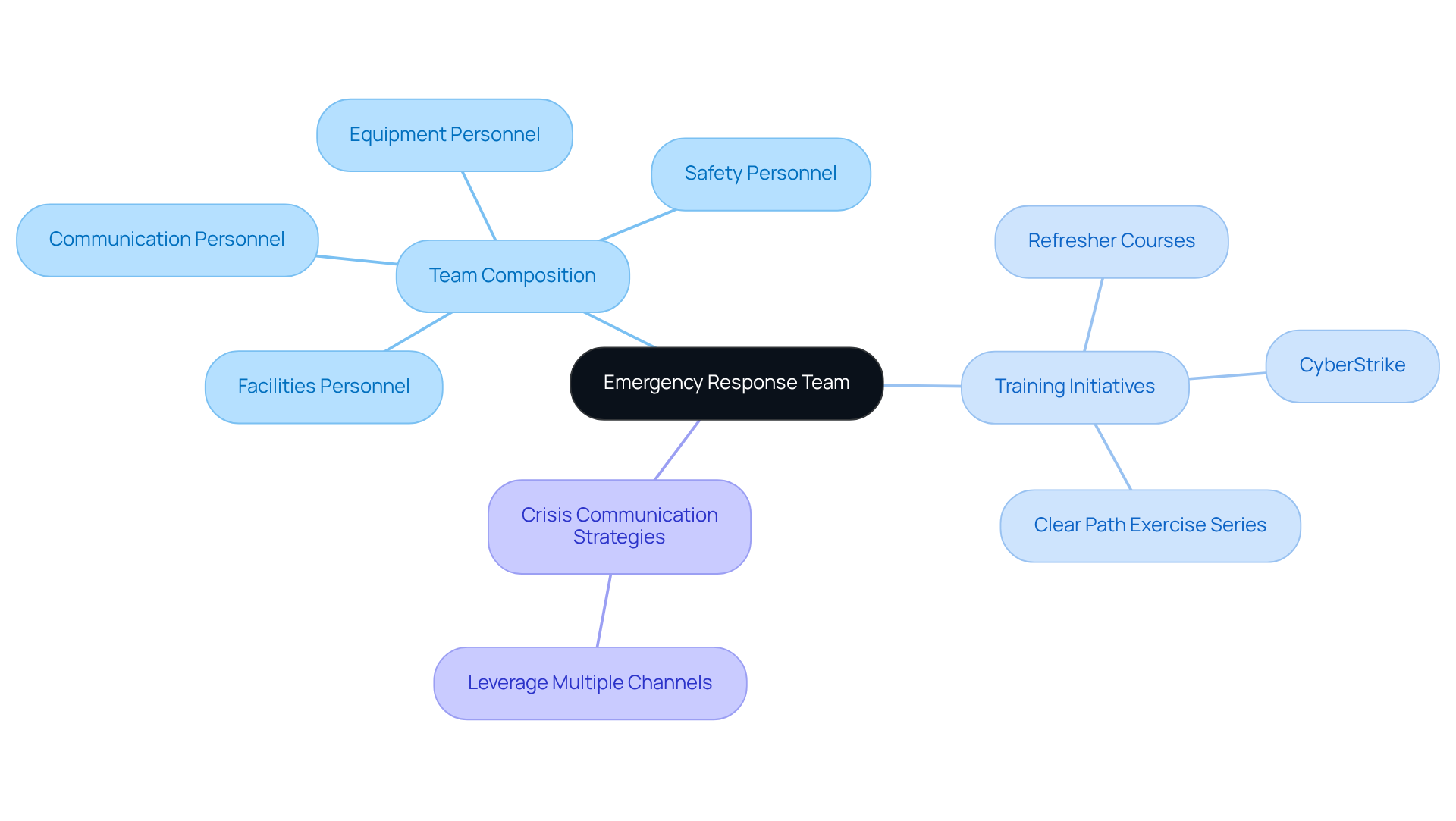
Assess Available Resources for Emergency Response
Conducting a thorough assessment of resources for emergency response is critical for effective power outage risk management. This assessment encompasses the evaluation of:
- Backup energy sources
- Communication tools
- Personnel preparedness
Notably, statistics reveal that in 2020, 14.3% of U.S. households possessed a backup generator, indicating a rising trend in private alternatives to grid reliability. For energy firms, maintaining an adequate inventory of backup energy sources is vital, especially considering that weather-related disruptions accounted for 83% of all outages from 2000 to 2021, resulting in annual costs ranging from $20 million to $55 billion.
When gaps in resources are identified, organizations must develop a strategic approach to acquire additional supplies or forge partnerships with external providers. By proactively managing their resource inventories, organizations can bolster their resilience against energy disruptions and improve their power outage risk management to ensure the continuity of operations.
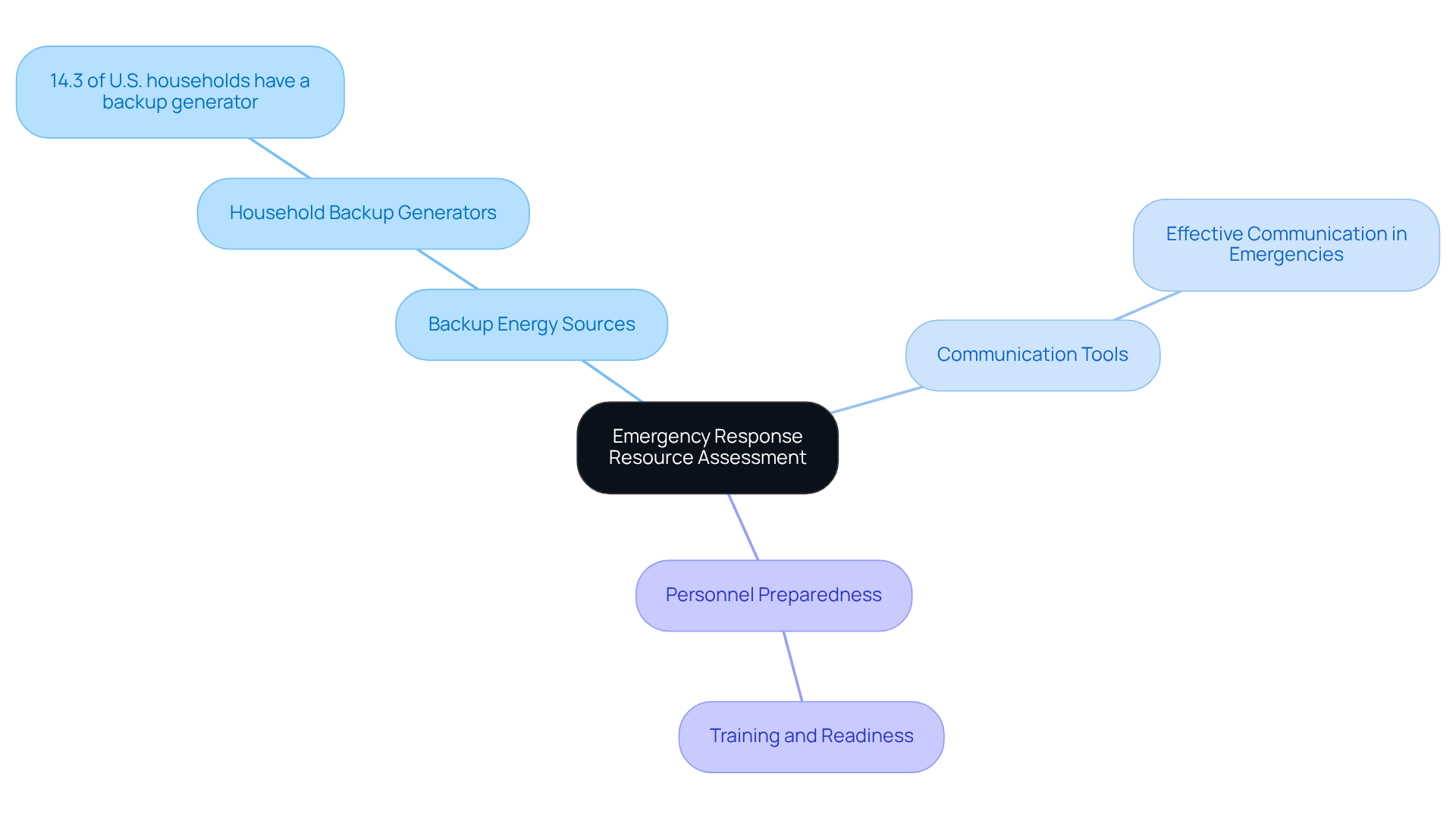
Document the Emergency Response Plan
Proper documentation of the crisis response strategy is not just important; it is essential for effective power outage risk management. This documentation must encompass:
- Detailed procedures
- Clearly defined roles and responsibilities
- Comprehensive contact information for key stakeholders
Accessibility is paramount; all team members must be well-versed in the plan and have it readily available during crises. Regular reviews and updates are crucial to ensure that the documentation reflects any changes in personnel or procedures, thereby maintaining its relevance and effectiveness.
Crisis management experts assert that clear documentation significantly enhances response efficiency, enabling teams to act swiftly and cohesively. Furthermore, statistics reveal that accessible response documentation can improve overall reaction times by as much as 30%. This underscores the necessity of keeping records current and clear. As illustrated in a case study on disaster management, proactive documentation can save lives and mitigate damage, emphasizing the critical importance of clear and accessible response strategies.
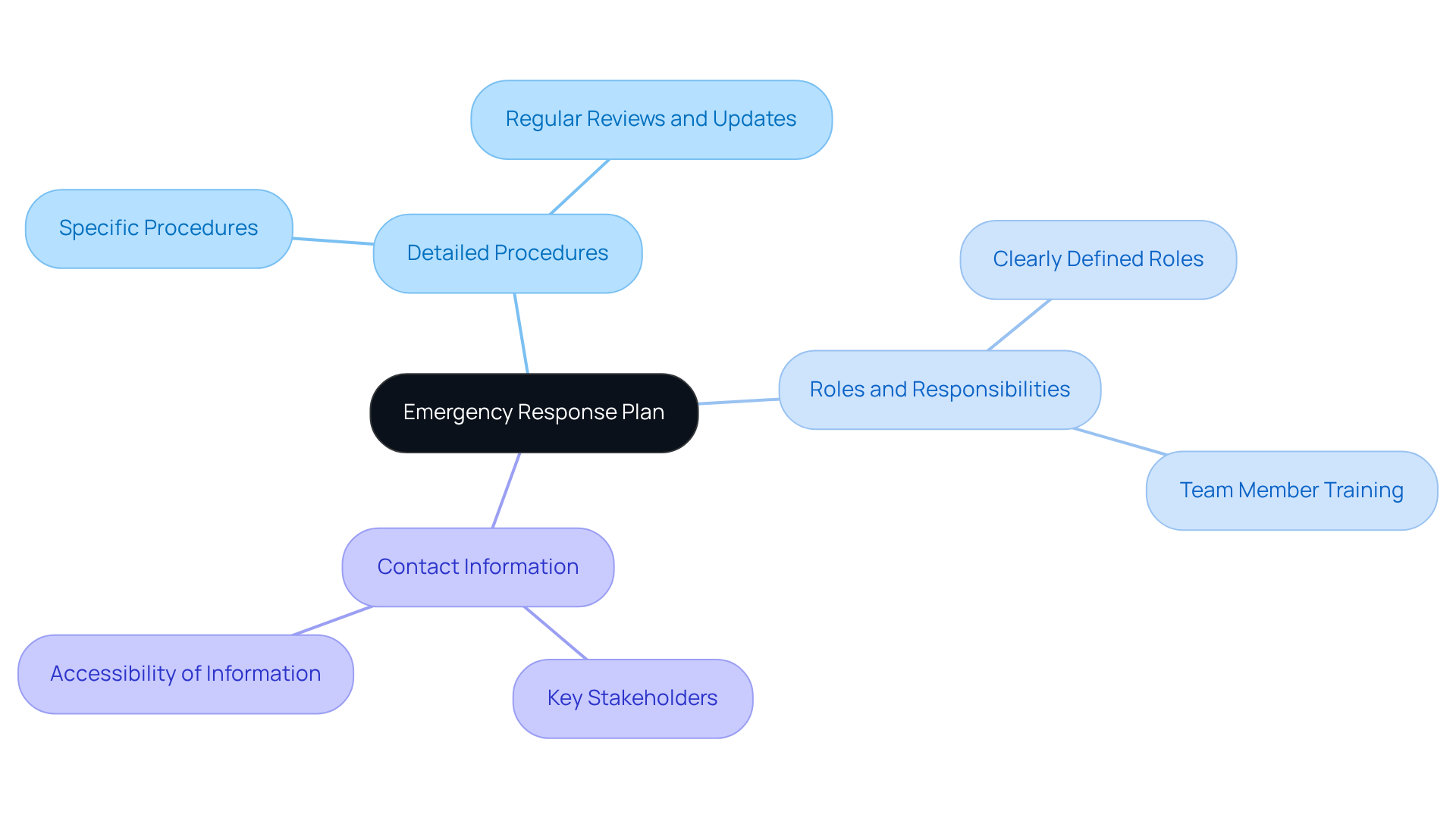
Test the Response Plan and Train Employees
Consistently assess your crisis response strategy through rigorous drills and simulations. These exercises should actively involve all team members, simulating diverse scenarios to measure the effectiveness of the strategy.
- Are your employees well-prepared for emergencies?
- Providing comprehensive training sessions is essential to ensure they are familiar with emergency procedures and their specific roles in power outage risk management.
- Ongoing training not only strengthens understanding but also significantly boosts confidence in the response strategy, ultimately enhancing organizational resilience.

Plan for Post-Outage Recovery
A robust post-outage recovery strategy is crucial for power outage risk management, as it minimizes disruptions and ensures a swift return to normal operations. This strategy must detail the steps for evaluating damage, restoring business operations, and effectively communicating with stakeholders. Key components include:
- Damage Assessment: Begin by evaluating the extent of the outage's impact on business operations. Identify affected systems, processes, and personnel.
- Restoration Procedures: Clearly outline procedures for restoring operations, prioritizing critical functions, and determining necessary repairs or adjustments.
- Communication Strategy: Develop a communication approach to keep stakeholders informed throughout the recovery process, including updates on recovery progress and any operational changes.
- Timeline and Responsibilities: Establish a recovery timeline, assigning specific responsibilities to team members to ensure a coordinated approach.
Recovery management experts emphasize that a well-defined recovery strategy not only aids in restoring operations but also enhances overall resilience against future disruptions. By implementing these measures, organizations can effectively manage the challenges posed by electrical interruptions with power outage risk management and mitigate their impact on business continuity.
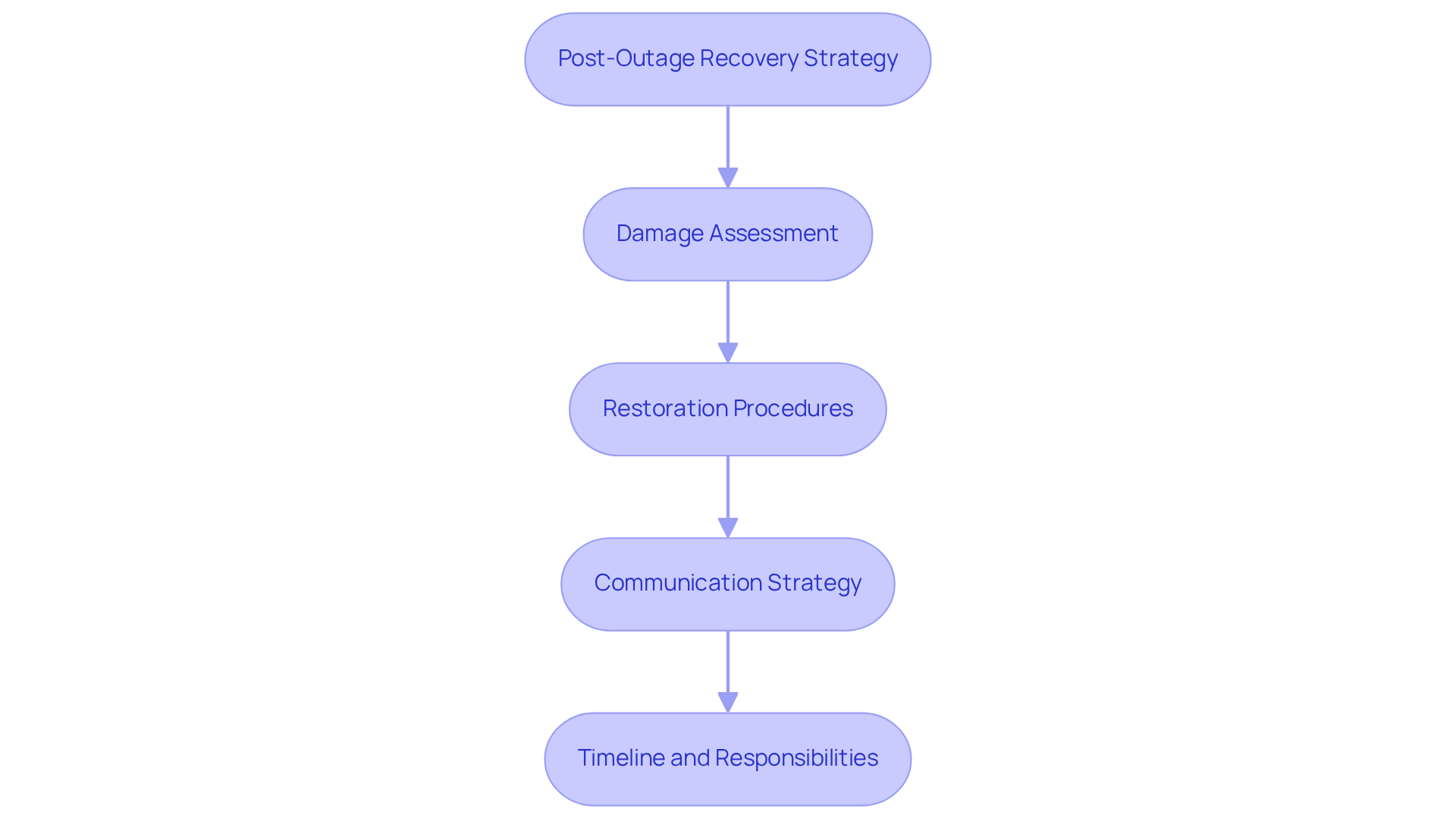
Review and Improve the Emergency Response Plan
Consistently examining and refreshing the emergency response strategy is crucial for effective power outage risk management. Organizations must evaluate lessons learned from drills and real incidents, as well as adapt to changes in organizational structure or operations.
How effectively are we preparing for the unexpected? Soliciting feedback from team members and stakeholders can uncover critical areas for improvement. For instance, 28% of U.S. employees reported low awareness regarding risk management, highlighting the urgent need for enhanced communication and training. Notably, 29% of U.S. employees cited inadequate staff training as a significant risk management challenge.
By fostering a culture of continuous improvement, organizations can significantly enhance their preparedness and resilience through power outage risk management against future power outages. This proactive strategy in power outage risk management not only reduces downtime—estimated at $9,000 per minute—but also ensures that response protocols remain relevant and efficient in the face of evolving risks.
Engaging in regular drills and incorporating insights from these exercises can lead to better resource utilization and communication effectiveness, ultimately strengthening the organization’s overall resilience. As Frost Tanner noted, "The issue lies in treating emergency plans as static documents when they need to adapt," underscoring the dynamic nature of emergency preparedness.
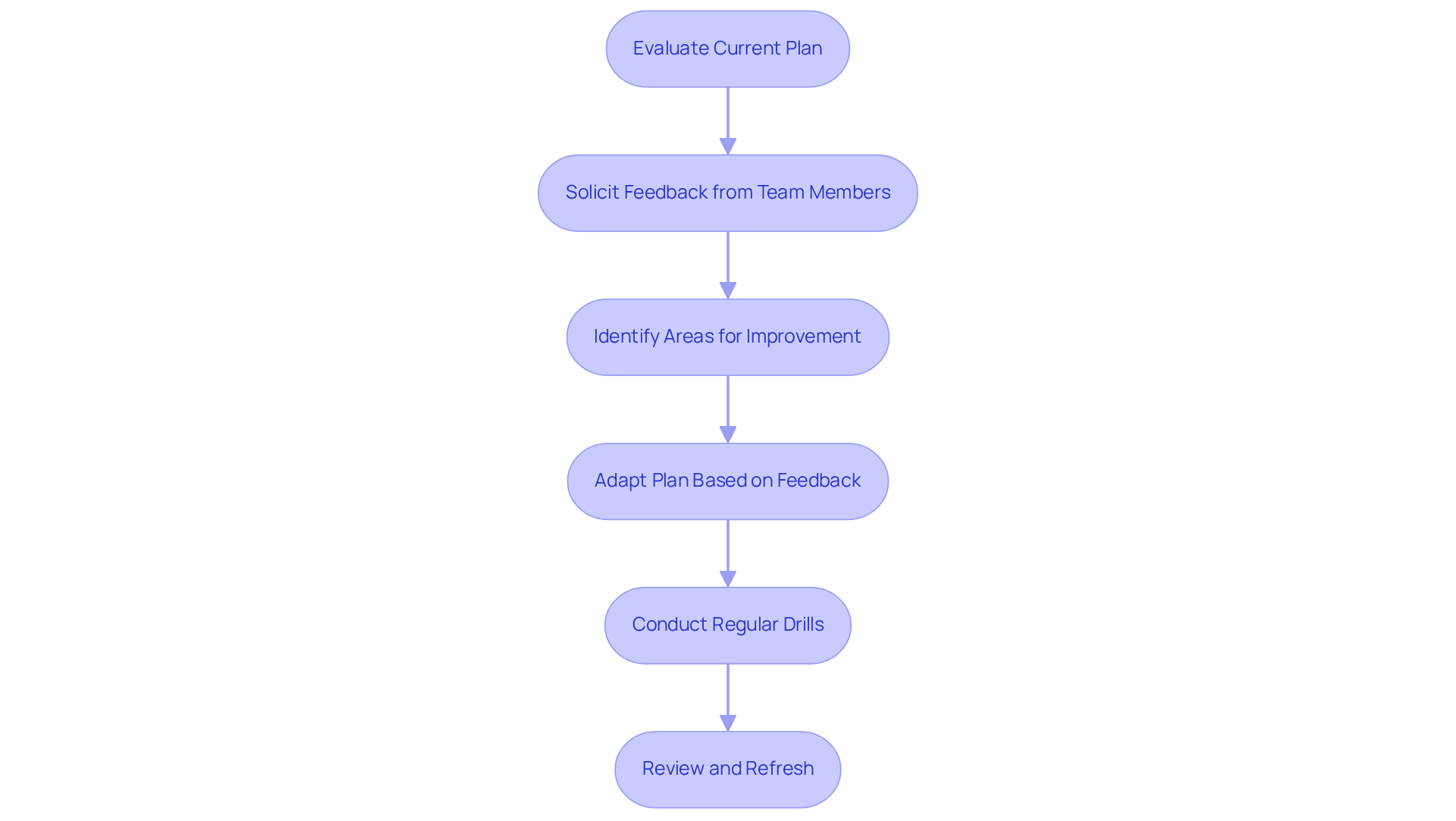
Conclusion
Effective power outage risk management is essential for ensuring the resilience of organizations confronted with electrical disruptions. By implementing a comprehensive strategy that encompasses preparation, response, and recovery, businesses can significantly mitigate the impact of power outages on their operations. This holistic approach safeguards critical functions and enhances overall organizational readiness in the face of unforeseen challenges.
The article outlines ten essential steps for managing power outage risks, including:
- Developing an emergency response plan
- Identifying potential threats
- Gathering stakeholder contact information
- Consistently testing and improving the response strategy
Each step plays a vital role in fostering a proactive culture of preparedness, emphasizing the importance of training, resource assessment, and clear documentation. Real-world examples, such as the Adaptive Networked Microgrid project, illustrate the effectiveness of these strategies in minimizing disruptions and ensuring a reliable energy supply.
Ultimately, organizations are encouraged to embrace a mindset of continuous improvement regarding power outage risk management. By regularly reviewing and updating emergency plans, engaging in drills, and fostering open communication among team members, businesses can enhance their resilience against future power outages. The proactive measures outlined not only reduce downtime but also empower organizations to navigate the complexities of electrical interruptions with confidence and efficiency.
Frequently Asked Questions
What services does Harbinger Land provide for power outage risk management?
Harbinger Land offers site and right-of-way acquisition, title research, GIS mapping, and data processing, all tailored to address the challenges of electrical interruptions.
How does Harbinger Land enhance operational efficiency?
They utilize advanced technologies, such as AI-powered title research software and integrated GIS modeling services, to significantly improve operational efficiency and client satisfaction.
What role does document imaging play in Harbinger Land's services?
Document imaging solutions help digitize property data, allowing title agents to conduct title research and leasing more cost-effectively by providing rapid access to extensive datasets.
Can you provide examples of projects that illustrate the effectiveness of Harbinger Land's approach?
The Adaptive Networked Microgrid (ANM) project by DTE Energy aims to reduce interruptions by up to 80% through renewable energy solutions. The Jamestown Community Microgrid Project emphasizes localized energy solutions to ensure essential services remain operational during disruptions.
Why is power outage risk management important in today's context?
Severe weather events significantly contribute to power disruptions, making proactive measures and innovative solutions vital for mitigating risks and ensuring the resilience of energy projects.
What are the key components of a successful power outage emergency response plan?
A successful plan should identify critical operations, establish communication protocols, and designate responsibilities among team members, with regular updates to maintain its relevance and effectiveness.
What potential threats to power supply should organizations evaluate?
Organizations should assess risks from natural disasters, equipment malfunctions, and cybersecurity vulnerabilities, as well as the aging infrastructure of the U.S. Energy Grid.
How do natural disasters impact energy supply?
Natural disasters can severely disrupt energy supply, as seen in Japan, prompting governments to prioritize comprehensive disaster management strategies.
What is the importance of conducting risk evaluations for power outage management?
Risk evaluations help organizations understand potential threats and develop effective strategies to reduce risks and enhance resilience against electricity interruptions.
List of Sources
- Harbinger Land | Comprehensive Solutions for Power Outage Risk Management
- U.S. electricity customers averaged five and one-half hours of power interruptions in 2022 - U.S. Energy Information Administration (EIA) (https://eia.gov/todayinenergy/detail.php?id=61303)
- A statistical model for risk management of electric outage forecasts (https://academia.edu/50332950/A_statistical_model_for_risk_management_of_electric_outage_forecasts)
- Weather-related Power Outages Rising | Climate Central (https://climatecentral.org/climate-matters/weather-related-power-outages-rising)
- Energy (https://infrastructurereportcard.org/cat-item/energy-infrastructure)
- Keeping the Lights On in Our Neighborhoods During Power Outages (https://energy.gov/gdo/articles/keeping-lights-our-neighborhoods-during-power-outages)
- Develop a Power Outage Emergency Response Plan
- 25 Business Continuity Statistics You Need to Know (https://invenioit.com/continuity/business-continuity-statistics?srsltid=AfmBOork6SfckWCHOGn81tKNO1UGvg5BBLJu_VeHLYzWxtKlt9l0OdQW)
- Spatiotemporal distribution of power outages with climate events and social vulnerability in the USA - PMC (https://pmc.ncbi.nlm.nih.gov/articles/PMC10147900)
- Weather-related Power Outages Rising | Climate Central (https://climatecentral.org/climate-matters/weather-related-power-outages-rising)
- 50 Quotes on Crisis Management & Leadership that Will Make You Think (https://ewweb.com/home/article/21127954/50-quotes-on-crisis-management-leadership-that-will-make-you-think)
- Identify Potential Threats to Power Supply
- (PDF) Impact of Natural Disasters on Electricity Supply [Guest Editorial] (https://researchgate.net/publication/224221616_Impact_of_Natural_Disasters_on_Electricity_Supply_Guest_Editorial)
- 3 Alarming Threats To The U.S. Energy Grid – Cyber, Physical, And Existential Events (https://forbes.com/sites/chuckbrooks/2023/02/15/3-alarming-threats-to-the-us-energy-grid--cyber-physical-and-existential-events)
- Social vulnerability to long-duration power outages (https://sciencedirect.com/science/article/pii/S2212420922007208)
- Equipment failure rate in electric power distribution networks: An overview of concepts, estimation, and modeling methods (https://sciencedirect.com/science/article/abs/pii/S1350630722010019)
- State and Regional Energy Risk Profiles (https://energy.gov/ceser/state-and-regional-energy-risk-profiles)
- Gather Contact Information for Key Stakeholders
- Moments of Truth: How Effective Communication During Power Outages Can Transform CSAT - Chartwellinc (https://chartwellinc.com/moments-of-truth-how-effective-communication-during-power-outages-can-transform-csat)
- Utilities can turn to software for proactive outage communication to avoid leaving customers in the dark (https://utilitydive.com/spons/utilities-can-turn-to-software-for-proactive-outage-communication-to-avoid/738261)
- Enhancing Utility Outage Communications: Strategies for Effective Internal Organization (https://messagebroadcast.com/enhancing-utility-outage-communications-strategies-for-effective-internal-organization)
- None (https://agilityrecovery.com/article/power-outage-impacts-and-preparedness-guidance-businesses)
- A dataset of recorded electricity outages by United States county 2014–2022 - Scientific Data (https://nature.com/articles/s41597-024-03095-5)
- Build an Emergency Response Team
- Emergency Preparedness – Stanford Environmental Health & Safety (https://ehs.stanford.edu/topic/emergency-preparedness/response-planning)
- Exercises and Training (https://energy.gov/ceser/exercises-and-training)
- Strategic Emergency Response Planning: Safeguarding the Energy Sector (https://leadventgrp.com/blog/emergency-response-planning-in-the-energy-sector)
- 7-Step Power Outage Emergency Response Plan [+ Template] (https://alertmedia.com/blog/power-outage-emergency-response-plan)
- Community Emergency Response Teams Training (CERT) | City of San José (https://sanjoseca.gov/your-government/departments-offices/office-of-the-city-manager/emergency-management/be-trained/community-emergency-response-team-training)
- Assess Available Resources for Emergency Response
- None (https://agilityrecovery.com/article/prepare-business-power-outage)
- Backup Power: Public Implications of Private Substitutes for Electric Grid Reliability | Journal of the Association of Environmental and Resource Economists: Vol 11, No 6 (https://journals.uchicago.edu/doi/10.1086/730158)
- Power Outage Statistics | Woodstock Power Company (https://woodstockpower.com/blog/power-outage-statistics)
- EIA data show average frequency and duration of electric power outages - U.S. Energy Information Administration (EIA) (https://eia.gov/todayinenergy/detail.php?id=27892)
- Uptime Institute’s 2022 Outage Analysis Finds Downtime Costs and Consequences Worsening as Industry Efforts to Curb Outage Frequency Fall Short (https://uptimeinstitute.com/about-ui/press-releases/2022-outage-analysis-finds-downtime-costs-and-consequences-worsening)
- Document the Emergency Response Plan
- Emergency Management by Statistics: for Resilient Future (https://profiletree.com/emergency-management-by-statistics)
- 50 Quotes on Crisis Management & Leadership that Will Make You Think (https://ewweb.com/home/article/21127954/50-quotes-on-crisis-management-leadership-that-will-make-you-think)
- (https://emdat.be)
- Test the Response Plan and Train Employees
- Assessment of the effectiveness of hospital external disaster functional drills on health care receivers’ performance, using standardized patients and mass cards simulation: a pilot study from Saudi Arabia - BMC Emergency Medicine (https://bmcemergmed.biomedcentral.com/articles/10.1186/s12873-024-01095-7)
- What is the value of health emergency preparedness exercises? A scoping review study (https://sciencedirect.com/science/article/pii/S2212420916304095)
- Evaluating the effectiveness of an emergency preparedness training programme for public health staff in China - PMC (https://pmc.ncbi.nlm.nih.gov/articles/PMC7111704)
- Evaluation of emergency drills effectiveness by center of disease prevention and control staff in Heilongjiang Province, China: an empirical study using the logistic-ISM model - PMC (https://pmc.ncbi.nlm.nih.gov/articles/PMC10936000)
- Improving Disaster Preparedness Among Healthcare Professionals: A Comprehensive Approach - Eurasian Journal of Emergency Medicine (https://eajem.com/articles/improving-disaster-preparedness-among-healthcare-professionals-a-comprehensive-approach/doi/eajem.galenos.2025.51482)
- Plan for Post-Outage Recovery
- 30 Disaster Recovery Stats You Should Know (https://impactmybiz.com/blog/disaster-recovery-stats)
- 2024 Disaster Recovery Statistics That Prove You're at Risk (https://linkedin.com/pulse/2024-disaster-recovery-statistics-prove-youre-risk-dale-shulmistra-kzqwe)
- 25 Disaster Recovery Statistics That Prove Every Business Needs a Plan (https://linkedin.com/pulse/25-disaster-recovery-statistics-prove-every-business-needs-dale)
- The True Cost of Downtime: 21 Stats You Need to Know (https://trilio.io/resources/cost-of-downtime)
- phoenixnap.com (https://phoenixnap.com/blog/disaster-recovery-statistics)
- Review and Improve the Emergency Response Plan
- 6 Vulnerabilities in Manufacturing Emergency Response & Preparedness (https://facilityos.com/blog/manufacturing-emergency-response-preparedness-challenges-how-to-fix)
- phoenixnap.com (https://phoenixnap.com/blog/disaster-recovery-statistics)
- 25 Disaster Recovery Statistics That Prove Every Business Needs a Plan (https://invenioit.com/continuity/disaster-recovery-statistics?srsltid=AfmBOoqhegbaTgh4wsyZeX1Jfn5ZYElIcFQA9qZEieAG5kE-Ulw55Ltm)
- How Companies are Falling Short Globally in Emergency Preparedness – New Survey Data (https://fusionrm.com/blogs/american-and-international-companies-preparing-for-emergencies)
- How often should an Emergency Response Plan be reviewed and updated? | Simple But Needed (https://sbnsoftware.com/blog/how-often-should-an-emergency-response-plan-be-reviewed-and-updated)




